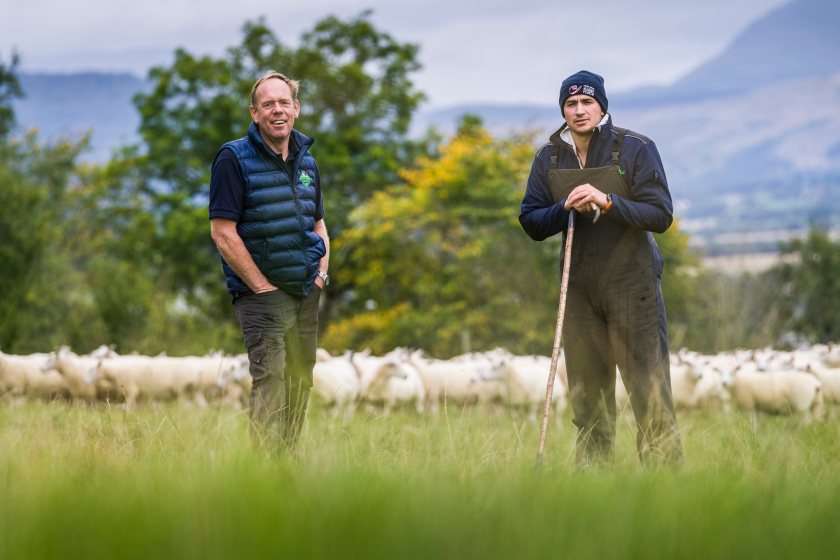
Maximising output and minimising inputs by creating a more efficient system has proved to be the key to success for Perthshire farmer Calum McDiarmid, who recently won the Scottish Sheep Farm of the Year title.
Calum, along with his shepherd Ed Munt, run 1,350 cross Aberfield breeding ewes and 350 ewe lambs at Mains of Murthly, located near Aberfeldy.
A decision to radically alter the farm’s sheep enterprise over the last five years has seen them become Scottish Sheep Farm of the Year, unveiled at the recent AgriScot event.
The biggest change has been to introduce a rotational paddock grazing system, with most fields now subdivided into seven to 10-acre paddocks using solar electric fencing systems.
This has had a dramatic impact on the volume and quality of grass grown on the unit, which has a difference in height from the bottom to the top of the farm of 700 feet.
In January, all ewes move into small batches of about 200 on eight-acre hill paddocks where they remain until two weeks before lambing, with ewe lambs on lower pastures.
Ewes receive high quality silage in ring feeders, and are condition scored every four weeks, with any requiring more condition taken out and receiving supplementary feed.
The farm’s silage is analysed every year, and has an average ME of about 11.2 and protein of 12.5%, giving a D-value of about 70.
“The Aberfield ewe is brilliant at living on silage in the January-February period,” Calum says. Quality grass and silage also drives colostrum quality and volume.
Lambing starts in early April, with ewes out on the hill until late March. Lambing is fast-paced on the unit, with the 100 small pens used for lambing twin- and triplet-bearing ewes becoming a ‘very busy place’ – but the key is to have a very well organised system, he says.
Thinking about how the entire enterprise works and making it as livestock - and people - friendly as possible is important.
“There are fewer shepherds around, so we have to create a business structure that people want to work in, to have good working conditions and a good work-life balance.”
And while the system as a whole is successful, one thing the farm would like to achieve is a better scanning percentage.
This has been as low as 160, and after reviewing the system, Calum and Ed believe it is down to a slight dip in ewe feed intake during the ‘golden period’ after tupping.
This has led to a change in approach this year to ensure ewes are on good grass for 30 days after tupping.
The additional grass – which is also useful at lambing – has come about as a consequence of dropping 30 acres of rape and kale, previously used for finishing lambs.
As a result, about half of the lamb crop were sold as stores this autumn, achieving a price of about £90, and the other half sold fat, achieving £115, but with an additional cost of £25/head to get them to that stage.
Traditionally, all lambs were sold deadweight at an average of 19kg, grading at U3L or 3H; the aim this autumn is to finish half the lambs again, but purely on better autumn grass which will have winter legumes stitched in.
The change in approach will mean the farm can give more grass to the ewes around egg implantation, which should boost lambing percentage, Calum says.
Focusing on grass and introducing the rotational paddock system has led to an improvement in flock health as sheep are moved to clean paddocks every five to seven days.
The farm has a policy that sheep can never graze two fields at the same time, so never running through a gate on the same track. This has had a huge impact on foot health.
With a belief that prevention is better than cure, ewes are blood tested for mineral deficiencies every two years, tested for MDV and Johne’s disease, and observed for OPA. “Thankfully none of these has been found, but we always look.”
Condition scoring and separating ewes has become more straightforward with the purchase of an integrated Ritchie Combi Clamp and Tru-Test XR5000 weigh head.
This is situated in the indoor sheep fank, which has a concrete floor. All sheep are recorded and measured every time they go through the fank, and the floor is scraped clean every week as part of the farm’s foot health programme.
As well as investing in fencing and handling facilities, the farm now has an Opico Sward Lifter, which Calum says is really helping to increase grass growth.
“With paddocks getting a rest between rotations and allowing the grass to grow, the root growth is tremendous," he says.
The newest piece of kit to arrive at Mains of Murthly is a plate meter, allowing the team to regularly measure each paddock’s grass output and chart it against lamb growth rates, creating a grass production chart for the farm.
“What can be done with good grass is surprising,” says Calum. “As farmers we have to drive our businesses harder, like every other industry, and we have managed to achieve much greater output with fewer inputs.”
Kate Rowell, Quality Meat Scotland (QMS) chair, praised Mains of Murthly for standing out due to their team approach and the opportunity Calum was giving Ed to drive the business forward.
“From a QMS point of view, I was impressed with the simplicity of the system, the way the business has adapted to meet current challenges and the best use of available land with rotational grazing.
"Also the fact that they're happy to change what they do to find the best way forward and are so open to new ideas.”
